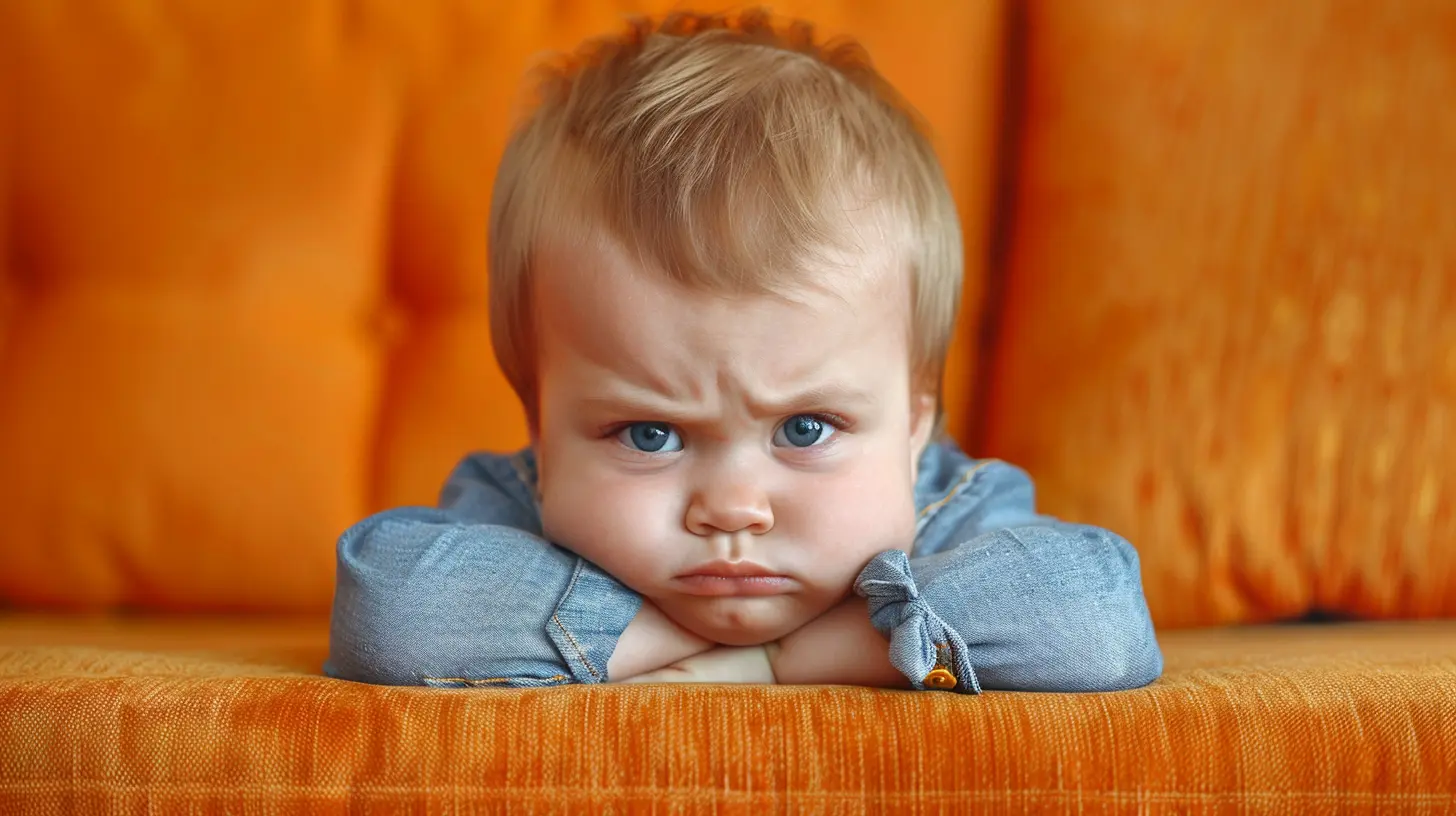Why Tantrums Are a Sign of Growth and How to Handle Them
4 February 2025
Parenting can feel like a rollercoaster on the best days—adorable giggles followed by tantrums that make you question if aliens have temporarily abducted your sweet child. It’s enough to leave any parent feeling confused, flustered, and maybe even a little defeated. But here's the good news (yes, there's good news!): tantrums are more than just explosive outbursts of frustration—they're actually a sign of growth and development.
Yes, you read that right. Tantrums represent progress in your child’s emotional and cognitive development. I know it sounds counterintuitive—kind of like calling a huge traffic jam "a sign of progress in city infrastructure"—but once you understand the science and psychology behind it, it all starts to make sense.
Let’s take a deep breath together and dive into why tantrums are not your enemy, but a crucial part of your child’s journey to independence, emotional understanding, and problem-solving. Stick around because we’re also going to talk about how you can handle these tantrums like the parenting pro you are (or are about to be!).
Why Do Kids Have Tantrums?
The Brain Is a Work in Progress
First, let’s get a little science-y for a minute. Did you know that a child’s brain isn’t fully developed until their mid-20s? Yep, you read that right! It takes years and years for the brain’s executive functions to fully mature. The prefrontal cortex—the part responsible for impulse control, emotional regulation, and reasoning—is still very much a work in progress for toddlers and young children.Think of it like giving them a car without the brakes installed just yet. They want to go, they know how to go, but stopping or slowing down? Not so much.
Their emotional outbursts aren't a sign that they are "bad" or "disobedient." They are simply overwhelmed, and tantrums are how they express that. It’s like a volcano that doesn’t yet have a safety valve—it erupts when the pressure gets too intense.
Language Development Plays a Role
Kids usually experience more tantrums between ages 1 and 3. This is no coincidence. At this age, their language skills are just starting to develop, and they often don’t have the words to express how they feel. Imagine how frustrating it would be if you were bursting with emotions but didn’t have the vocabulary to tell someone what was wrong.For example, ever notice how many tantrums happen when your child is hungry, tired, or frustrated? It’s not just because they’re in discomfort; it’s also because they can’t articulate their needs the way adults can. Tantrums become their default form of communication—a way to say, “Something’s not right over here!"
Why Tantrums Are Actually a Sign of Growth
Emotional Development
Tantrums are a neon sign that your child is learning to navigate their emotions. While it may look and sound chaotic (oh, the ear-splitting demands for the blue cup that you cannot find anywhere!), what’s happening on a deeper level is emotional growth. Your child is beginning to differentiate between emotions like frustration, anger, sadness, and disappointment.Although they don’t have the tools to effectively manage these emotions yet, they're starting to recognize them—and that’s important! Emotional intelligence doesn’t come overnight. Tantrums are simply part of the messy process. Think of them as emotional "growing pains."
Building Independence
Every tantrum is also a sign that your child is striving for autonomy. They’re realizing that they are independent beings with their own needs and desires. The problem? They don’t always know how to express those desires in a socially acceptable way—especially when their needs clash with yours.When your toddler insists on feeding themselves, even though they haven't quite mastered the art of spooning peas without launching them across the kitchen? That's independence kicking in. When they scream because they want to wear rain boots on a sunny day? That’s them making autonomous choices (although questionable).
Instead of seeing a tantrum as defiance, try to see it as a declaration: "I am my own person!" And honestly, isn’t that what we ultimately want for our kids? We want them to grow into independent, confident adults who recognize and advocate for their needs.
The Different Types of Tantrums
You might be surprised to learn that there are different kinds of tantrums, each with its own flavor. Understanding which category your child's tantrum fits into can help you respond more effectively.1. Hunger-Induced Meltdowns
These are pretty self-explanatory. Remember how we mentioned kids can’t always express their needs? Well, hunger-induced tantrums are a classic example. If your child is hungry and doesn’t have the words to tell you, a meltdown is likely just around the corner.2. Overstimulation Tantrums
Ever been to a birthday party with loud music, flashing lights, and a bunch of hyped-up children? Yeah, sensory overload can lead to some epic meltdowns. Overstimulation can be overwhelming for kids, and they don’t always know how to dial things back.3. Frustration-Based Tantrums
These tend to happen when kids are trying to complete a task but can’t quite figure it out (like trying to fit a square peg into a round hole). Frustration builds, and—boom—everything escalates.4. Attention-Seeking Tantrums
Sometimes, a tantrum is just your child’s way of saying, “Hey! Look at me!” It’s their version of waving a flag when they feel like they’re not getting enough attention—whether it’s positive or negative attention, they’ll take it all the same.5. Power Struggles
These tantrums show up when your child feels powerless and wants to assert control. They demand a cookie before dinner, and when you say “no,” the tears and screaming start. Basically, they want things their way—right now.
How to Handle Tantrums: Proven Strategies
Alright, now that we understand tantrums better, let's dive into how to handle them like a parenting ninja.1. Stay Cool, Even When They’re Not
It’s easier said than done, right? But hear me out for a second. Kids are highly intuitive, and they pick up on our emotions. When you respond to their screaming with yelling (admittedly tempting at times), it’s like throwing gasoline on a fire. Instead, try to keep your cool—breathe deeply, stay calm, and model the kind of behavior you want them to emulate.2. Validate Their Emotions
One of the most powerful things you can do in the midst of a tantrum is validate your child’s feelings. No, you don’t have to give them the blue cup or let them wear rain boots in the middle of summer. But saying something like, “I see that you’re really upset because you wanted the blue cup," helps them feel understood.It might not stop the tantrum right away, but long-term, it teaches them that their emotions are valid and that they can express their feelings in a healthy way.
3. Offer Choices
When power struggles are at play, offering limited choices can be a game-changer. Instead of saying, "Put on your shoes right now," try, "Would you like to wear your red shoes or your blue shoes today?" This gives them a sense of control without letting them run the show entirely.4. Teach Emotional Regulation Over Time
Here's the tough truth: kids don't automatically know how to deal with overwhelming emotions. It's something they have to learn—and guess who their teacher is? Yep, it’s you!Start teaching them emotional regulation in small ways, like using words to describe their feelings (“You’re really frustrated because we have to leave the park, huh?”) and introducing calming strategies like deep breathing or counting to ten.
5. Use Distraction Wisely
Sometimes, the best way to defuse a tantrum is to simply redirect their attention. This works especially well for younger toddlers. If they’re throwing a fit over not getting to play with your phone, maybe suddenly pulling out a fun toy or suggesting a dance party might shift their focus.The Light at the End of the Tantrum Tunnel
Tantrums won't last forever (phew!). While they are a normal and healthy part of childhood development, your little one will outgrow them as they build better communication and emotional regulation skills.It’s all part of their emotional and cognitive growth, kind of like how a butterfly has to struggle to emerge from its chrysalis before it can fly. Believe it or not, every tantrum your child experiences is helping them learn how to manage frustration, express themselves, and make decisions.
Conclusion: Embrace the Chaos (Sort of)
So, the next time your child is on the verge of a meltdown because you gave them the wrong-colored sippy cup, remember this: tantrums are natural, necessary, and—believe it or not—a sign that your child is growing. While they can be tough to handle in the moment, they’re also an opportunity for you to guide your child towards emotional intelligence and independence.You’ve got this! Now take a deep breath, and let’s tackle those tantrums like the pros we are.
all images in this post were generated using AI tools
Category:
Tantrum TipsAuthor:

Maya Underwood
Discussion
rate this article
10 comments
Camden Barker
Tantrums? Just tiny humans flexing their emotional muscles. Let's keep it real, parents!
March 23, 2025 at 5:48 AM

Maya Underwood
Absolutely! Tantrums are indeed a natural part of emotional development. They help children express feelings and learn to navigate complex emotions. Embracing this growth can make parenting a bit easier!
Emery Bailey
Embracing tantrums as growth moments fosters understanding and stronger bonds.
March 10, 2025 at 3:16 PM

Maya Underwood
Thank you for your insight! Embracing tantrums indeed helps us develop empathy and strengthen our relationships.
Phoebe Hodge
Tantrums aren’t failures; they’re milestones! Embrace these outbursts as your child's emotional growth. With understanding and patience, you’ll foster resilience and teach them to navigate their feelings.
February 25, 2025 at 5:56 AM

Maya Underwood
Thank you for your insightful comment! Absolutely, tantrums are indeed an important part of emotional development, and approaching them with understanding can foster resilience in children.
Fenris Barker
Understanding tantrums helps nurture emotional growth in our children effectively.
February 22, 2025 at 4:17 AM

Maya Underwood
Absolutely! Recognizing tantrums as a natural part of emotional development allows us to respond with empathy, fostering resilience and healthy expression in our children.
Peregrine Diaz
Interesting perspective! It's fascinating how tantrums can reflect growth. Can't wait to learn more about effective strategies for handling them!
February 16, 2025 at 4:17 PM

Maya Underwood
Thank you! I’m glad you found it interesting. Stay tuned for more insights on managing tantrums and fostering growth!
Lysander Hernandez
Every tantrum hides a secret; unraveling it can transform parenting.
February 15, 2025 at 5:35 AM

Maya Underwood
Absolutely! Understanding the underlying emotions of tantrums can foster empathy and strengthen the parent-child bond, making it a valuable opportunity for growth.
Halle Lewis
Such a great perspective! Embracing tantrums as growth makes parenting a bit easier!
February 14, 2025 at 5:07 AM

Maya Underwood
Thank you! I'm glad you found the perspective helpful. Embracing tantrums can truly transform the parenting experience!
Daniella Rodriguez
I loved this article! It’s so true—tantrums can feel like chaos at the moment, but they really are a sign that our little ones are learning to express themselves. Embracing these moments with patience makes all the difference. We’re all growing together on this parenting journey!
February 12, 2025 at 3:23 PM

Maya Underwood
Thank you for your thoughtful comment! I'm glad the article resonated with you. Embracing these moments is indeed crucial for both parents and children.
Gianna McGhee
Tantrums are natural milestones in emotional development. They signal a child’s struggle to express feelings and assert independence. Responding with patience and understanding fosters resilience, teaching them how to navigate their emotions constructively as they grow.
February 11, 2025 at 5:34 PM

Maya Underwood
Thank you for highlighting the importance of patience and understanding during tantrums. It’s essential for fostering emotional resilience in children as they learn to navigate their feelings.
Geneva Fry
This article beautifully reframes tantrums as a natural part of growth. It’s a reminder that our children's emotional outbursts are not just challenges, but opportunities for connection and understanding. Embracing this perspective can make the parenting journey more enriching for both us and our little ones.
February 10, 2025 at 4:53 PM

Maya Underwood
Thank you for your thoughtful comment! I'm glad you found the reframing of tantrums as growth opportunities helpful. Embracing these moments can truly enrich our parenting experiences.
MORE POSTS

How to Redefine Productivity When You’re a Stay-at-Home Mom

Approaching Chores from a Montessori Perspective

How to Stop Repeating Yourself: Making Your Requests Stick

How to Balance Bonding Time with Establishing Good Sleep Habits

The Importance of Modeling Positive Behavior in Discipline

Building a Strong Parent-Teacher Relationship in Preschool

How a Simple Breathing Exercise Can Calm a Tantrum